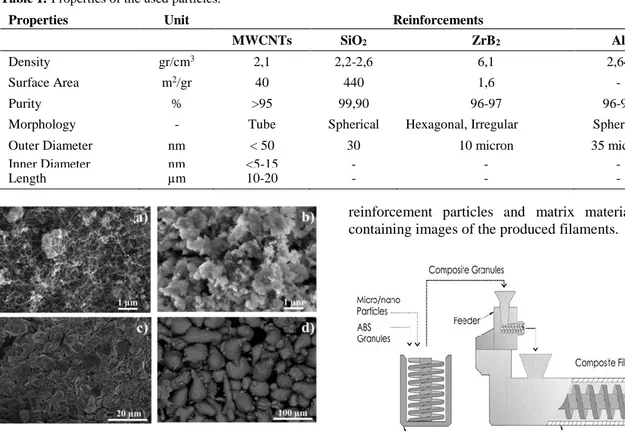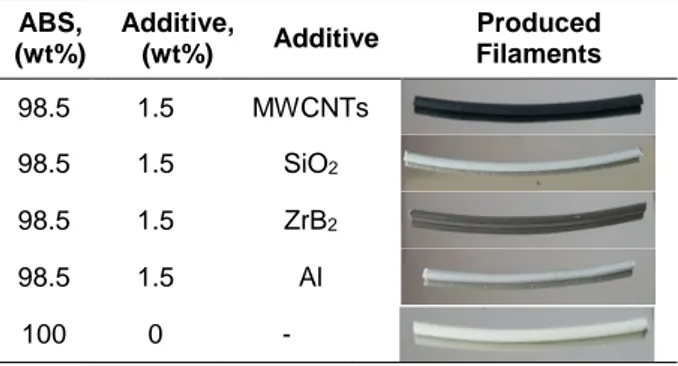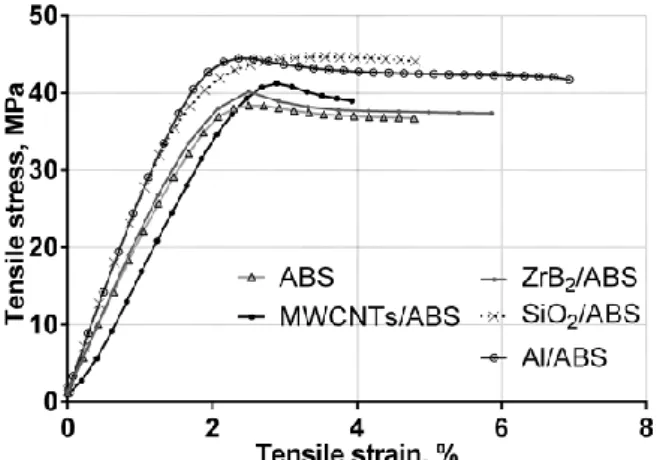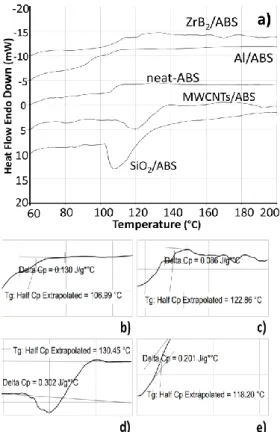Production and Characterization of Composite
Filaments for 3D Printing
Araştırma Makalesi / Research Article
Ebubekir ÇANTI1, Mustafa AYDIN2*, Ferhat YILDIRIM3
1TUBITAK, BILGEM BTE, Gebze/Kocaeli, Turkey
2*Hasan Ferdi Turgutlu Technology Faculty, Department of Mechanical and Manufacturing Engineering, Manisa Celal Bayar University, Turkey
3Faculty of Simav Technology, Department of Industrial Design Engineering, Dumlupinar University, Turkey (Geliş/Received : 18.04.2017 ; Kabul/Accepted : 03.06.2017)
ABSTRACT
In this study, various nano and micro particles with different properties, including density, surface area, purity and particle morphology were used as reinforcement particles for the production of polymer composite filaments to be used for 3D printing. Acrylonitrile Butadiene Styrene (ABS) was matrix material and Multi wall carbon nanotubes (MWCNTs), SiO2, ZrB2, and, Al particles were reinforcements. Production of the composite filaments was carried out by using a twin screw extruder. Produced composite filaments were characterized via Differential Scanning Calorimeter (DSC), Scanning Electron Microscope (SEM), Energy-Dispersive X-ray Spectroscopy (EDS), tensile test and surface roughness tests. Results showed that addition of micro/nano particles into ABS matrix improved the Ultimate Tensile Strength (UTS) of the composites by around 16% compared to non-reinforced one. As a result of reinforcing with micro particles, ZrB2 and Al, the tensile strain of neat-ABS filament increased by 17.8% and 40%, respectively
Keywords: Additive manufacturing, polymer, ABS, composite, filament, FDM
The Üç Boyutlu Yazım İçin Kompozit Filamentlerin
Üretimi ve Karakterizasyonu
ÖZ
Bu çalışmada, yoğunluk, yüzey alanı, saflık ve parçacık morfolojisi gibi farklı özelliklere sahip çeşitli nano ve mikro parçacıklar, 3D baskıda kullanılacak polimer kompozit filamentlerin üretimi için takviye parçacıkları olarak kullanılmıştır. Akrilonitril Bütadien Stiren (ABS) matris malzemesi iken, MWCNTs, SiO2, ZrB2, Al partikülleri takviye olarak kullanılmıştır. Kompozit filamentlerin üretimi ikiz vidalı bir ekstrüder kullanılarak gerçekleştirilmiştir. Üretilen kompozit filamentler Diferansiyel Taramalı Kalorimetri (DSC), Taramalı Elektron Mikroskopu (SEM), Dispersif X-ışını Spektroskopisi (EDS), çekme testi ve yüzey pürüzlülük testleri ile karakterize edilmiştir. Sonuçlar, ABS matrise mikro/nano parçacıklarının eklenmesinin, takviyesiz ABS ile karşılaştırıldığında kopma gerilmesini yaklaşık %16 oranında geliştirdiğini göstermiştir. ZrB2 ve Al mikro parçacıklarının takviye edilmesi sonucunda, katkısız ABS filamentin çekme gerinimi sırasıyla %17.8 ve %40 kadar yükselmiştir.
Anahtar Kelimeler: Eklemeli üretim, polimer, ABS, kompozit, filament, FDM
1. INTRODUCTION
Additive manufacturing (AM) is a bottom up process based on creating objects directly from material layer by layer as opposed to traditional manufacturing methods that relies on subtraction of material from work piece. Because of this unique approach, AM allows to manufacture complex shaped parts with minimum scratch. Different AM techniques have been developed in the literature, including Laminated Object Manufacturing (LOM), Stereolithography (SLA), Selective Laser Sintering (SLS), and Fused Deposition Modelling (FDM). However, FDM is the most prominent and prevalent one due to simplicity of the FDM devices and wide availability of the materials [1].
Today, ABS, polycarbonate (PC), polylactide (PLA), polyamide (PA), and the mixtures of different types of thermoplastics are the most common feedstock material in other words filaments in FDM technique [2]. However, the parts to be manufactured using these filaments lack sufficient mechanical strength and robustness, due to inherent nature of the polymeric materials, to withstand mechanical loading, which is a prerequisite for all functional mechanical components. This shortcoming restricts implementation of the FDM technology significantly and limits its applicability to industrial applications. Therefore, there is an urgent need for development of novel materials with enhanced mechanical properties for manufacturing of functional mechanical components [3]. Polymer nano-composites stand out as a potential solution to overcome this limitation. Because of having larger surface area over a *Sorumlu yazar (Corresponding Author)
given volume by transition of the dimension scale from micrometer to nanometer, nanometer scaled particles improves mechanical and physical properties significantly of the polymer materials [4]-[6].
Even though the effects of manufacturing parameters on the mechanical properties of 3D printed parts have been vastly studied in the literature [7]-[10], developing novel filament thus achieving printed parts with superior properties is limited. Hence, the aim of the current study was to produce ABS micro/nano composite filaments with different reinforcements, including MWCNTs, SiO2, ZrB2, and Al and to characterize them.
2. MATERIAL and METHOD 2.1. Used Materials and Properties
In this study, MWCNTs, SiO2, ZrB2, and Al particles were used as reinforcement particles for the production of polymer composite filaments. The Al particles were produced by gas atomization method in “Gas atomization unit” in Dumlupinar University. The SiO2 and MWCNTs particles were supplied from Ege Nanotech (Izmir, Turkiye, code EN/N-EA234 and EN/N-KNT14-1, respectively). The ZrB2 particles were purchased from the ABCR (Karlsruhe, Germany, code 82299).
Material properties of used micro/nano particles were presented in Table 1. Figure 1 shows SEM microstructure of the reinforcement particles. As shown in Table 1 and Figure 1, the particles have different properties, including density, surface area, purity, and particle morphology.
Figure 1. The SEM microstructure of used micro/nano
particles, a) MWCNTs, b)SiO2, c) ZrB2, d)Al.
2.2. Fabrication of the Composite Filaments
A twin screw extruder, AES Lab-30 (Aysa Machine, Istanbul, Turkiye), was utilized for the filament production. The extruder has twin screw one of each has a diameter of 22 mm. Also, length/diameter (L/D) ratio of the extruder is 32. The machine can be operated in a temperature range 60oC-400oC precisely by the help of 6 heat zones and cooling installations located on themain barrel.
Production steps are illustrated in Figure 2. At first, mixing of the reinforcement particles with the ABS granules was done in a mechanical alloying machine without steel balls for ten minutes, in order to provide penetration of the fillers into the ABS granules. Following, the composite granules were poured into the feeder of the extruder machine to maintain uninterrupted extrusion process. For constant feeding, rotation speeds ofthe feeder and main twin screw were set to 15 rpm and 73 rpm, respectively. During the extrusion, main barrel temperature was controlled by the independent 6 heating zones which are located on. The temperatures of the heat zones, from 1st heat zone to last, were set in range 175oC to 210oC by equal increment. An extruder die contains only a single exit with a diameter of 2 mm was employed in the process. Having been extruded from die, the filaments dived into water pool (19oC) for solidification to 50 rpm to improve consistency of the filament diameter, which was resulted in a filament with diameter of 1.75 mm. Table 2, shows weight ratios of the
reinforcement particles and matrix material besides containing images of the produced filaments.
Figure 2. The production steps of nano-micro polymer
Table 1.Properties of the used particles.
Properties Unit Reinforcements
MWCNTs SiO2 ZrB2 Al
Density gr/cm3 2,1 2,2-2,6 6,1 2,64
Surface Area m2/gr 40 440 1,6 -
Purity % >95 99,90 96-97 96-98
Morphology - Tube Spherical Hexagonal, Irregular Spherical
Outer Diameter nm < 50 30 10 micron 35 micron
Inner Diameter nm <5-15 - - -
Table 2. The weight ratio of the particles added into the ABS matrix and produced filament images.
ABS, (wt%) Additive, (wt%) Additive Produced Filaments 98.5 1.5 MWCNTs 98.5 1.5 SiO2 98.5 1.5 ZrB2 98.5 1.5 Al 100 0 -
2.3. Characterization of ABS Composite Filaments The composite filaments were characterized via different methods, including DSC, tensile test, surface roughness, and SEM-EDS. Tensile test were performed on 4 samples extracted from various sections of the filaments then subjected to axial loading by using Zwick BF2-FZ0.5TH.D16 (Zwick, Germany) at room temperature. Maximum tensile load allowed by the tensile machine was of 5kN and extension resolution was <0.1 microns. Distance between grippers was set to 100 mm and all of the specimens were stretched at 25 mm/min with constant speed. SEM-EDS studies were conducted via FEI Nova NanoSEM 650 (FEI, Oregon, USA) in Advanced Technology Center at Dumlupinar University (ILTEM). DSC was performed on granulated filaments by using SETSYS Evolution TGA&DTA/DSC (SETARAM Instrumentation, USA) in the same center.
3. RESULTS AND DISCUSSION 3.1. SEM-EDS Analysis of the Filaments
Following the filament production, EDS studies of the composite filament’s cross sections have been obtained to validate dispersion of micro/nano particles in the ABS matrix. In Figure 3, EDS graphs were plotted. The EDS studies showed that reinforced particles were present in the ABS matrix.
Figure 3. The SEM-EDS plot of the composite filaments, a) MWCNTs/ABS, b) SiO2/ABS, c) ZrB2/ABS, and d) Al/ABS.
3.2. Tensile Test of the Filaments
Corresponding tensile stress to tensile strain, based on the tensile test results, were plotted in Figure 4 and presented in Table 3. According to results, nano-particle addition decreased elongation at break values by up to 17.8%. However, UTS values of the filaments increased by 6.7% and 16% by reinforcing MWCNTs and SiO2, respectively.
Micro particle reinforcement affects the tensile-strain more thoroughly than tensile-stress. Reinforcing with ZrB2 increased UTS 4.5% while its elongation at break increased 18%. Results were more promising with Al reinforcing. An UTS increase of around 16% and an elongation at break increase of around 40% were observed in Al reinforced filament. Young moduli of all filaments except MWCNTs were increased. Significant decrease, of around 18% was observed in MWCNTs reinforced filament.
Figure 4. The stress-strain graph of the produced ABS composite filaments.
Table 3.The weight ratio of the particles added into the ABS matrix and produced filament images.
Matrix Reinforcement Young Modulus, (GPa) UTS, (MPa) Elongation at break, (%) ABS - 2,05 38,44 4,99 ABS (nm) MWCNTs 1,68 41,2 4,05 ABS (nm) SiO2 2,49 44,72 4,84 ABS (μm) ZrB2 2,14 40,2 5,88 ABS (μm) Al 2,55 44,56 6,99
3.3. Comparison of the Filament Diameters
In Figure 5, cross section surfaces of both of neat-filament and the neat-filament reinforced with SiO2 were compared. Today, commercial FDM filaments, mostly, have a diameter of 1.75 mm. Following the extrusion process, produced filaments were used in an FDM printer for trials. Too thin or too thick filaments caused printing errors, interrupted the process, and made impossible to print fully integrated parts. Trial processes showed that the importance of the consistency of the filament diameter. In this study, neat andSiO2 reinforced filament were compared and their diameter measured as 1.771 mm and 1.741 mm, respectively. Results show that, by arranging the extrusion process parameters properly, achieving suitable filaments compatible with FDM printing can be provided either using reinforcement particles or not using.
Figure 5. The SEM microstructure of a) neat-ABS, b) SiO2/ABS composite filaments, X150 magnification.
SEM microstructures of fractured surface of tested filaments are shown in Figure 6. Fractured surface formations of the both non-reinforced filament and filament with ZrB2 reinforcement were almost same (Figure 6a, b). Fracture surface formation of the specimen with SiO2 reinforcement indicates ductile fracture same like filaments with non-reinforced and ZrB2 reinforced (Figure 6b, c). SEM images of these filaments indicated ductile fracture and show agreement with the elongation at break values were presented in Table 3 (4.84%, 4.99% and 5.88%; SiO2, non-reinforced and ZrB2, respectively). To validate presence of the micro Al alloy particle in the polymer matrix, the SEM image was added as Figure 6f.
3.4. SEM Microstructure of Fracture Surface Examination of the specimen with MWCNTs reinforcement showed agglomeration of the nano-tubes (Figure 6d, e). It can be said that there was non-uniform dispersion of MWCNTs in the ABS matrix, due to the morphology of MWCNTs and weak adhesion between particles and the ABS matrix. Besides, agglomeration of the particles in the cross section of the filament was acted as a stress concentrator resulted with poor capability to withstand failure. Although, UTS value of the filament with MWCNTs was slightly higher than the non-reinforced one, there was notable decrease in elongation at break value (4.99% and 4.05%, respectively; Table 3).
Figure 6.The fracture surface of neat-ABS and reinforced ABS filaments, a) neat-ABS X10.000, b) ZrB2/ABS X10.000, c) SiO2/ ABS X10.000 with higher magnification,
d) MWCNTs/ ABS X5000 with higher magnification, e) MWCNTs/ ABS X1000 (agglomeration) with X10.000 magnification, f) Al/ABS X1000.
The specimen with SiO2 has the highest UTS value presumably owing its morphology and of size. SiO2 particles have the highest surface area with the 440m2/gr value among all of the reinforcements with spherical morphology. This can be thought that the possible reason for the UTS increase for SiO2 reinforced filament. SEM images indicated more homogenized distribution of the reinforcement particles in the ABS matrix except MWCNTs.
3.5. DSC Studies of the Produced Filaments
For all of the produced filaments, results of the DSC studies were shown in Figure 8. According to results neat-ABS shows a glass transition temperature (Tg) around of 107°C. This finding was compatible with the result of Faes et al. study [11]. Also, there have been shown mixed values for Tg of the ABS from 105°C to 108°C in literature [[12], [13].
Figure 7.DSC studies of a) all produced samples, b) Al/ABS, c) ZrB2/ABS, d) MWCNTs/ABS, e) SiO2/ABS.
4. CONCLUSION
ABS composite filaments reinforced with different nano/micro particles have been successfully produced by using a twin screw extruder in this study. Characterization results shows that these novel composites can be used as filament material in commercial FDM devices without requiring modification. According to the results;
1- The nano and micro reinforced ABS composite filaments for FDM type 3D printer were produced via a twin screw extruder between 175oC - 210oC without degradation of the matrix.
2- DSC studies showed that produced filaments were compatible with commercial 3D printers because of having lower Tg values (maximum value was 130°C for MWCNTs/ABS nano composite) than standard processing temperatures of the commercial 3D printers (mostly 230°C). However, a Melt Flow Index (MFI) should be applied on the composite polymers for determining exact processing temperature. 3- Addition of micro sized particles (ZrB2 and Al alloy)
in the polymer matrix was resulted increase of the tensile strain at least 18%.
4- The EDS results showed that, in generally, the micro reinforcements were embedded and distributed in the ABS matrix well while nano particle reinforced filaments had local agglomeration and internal void problems.
5-
SEM microstructure of fracture surfaces indicated brittle fracture mode for the MWCNTs reinforced ABS filament as opposed to expectation. This can be aroused mainly by the weak matrix-filler interaction between polymer matrix and MCWCNTs filler.6- During the extrusion process, the nano composite
filaments need to be fabricated-granulated for a couple cycles to achieve well dispersion of the reinforcement particles in the ABS matrix.
ACKNOWLEDGEMENT
This study was supported by the Scientific and Technological Research Council of Turkey (TUBITAK) in the context of 2210-C Graduate Scholarship Program for Priority Areas. Also, the article was previously presented at the International Symposium on 3D Printing Technologies (3D-PTS 2017).
REFERENCES
[1]. Ning, F., Cong, W., Qiu, J., Wei, J., & Wang, S.,“Additive Manufacturing of Carbon Fiber Reinforced Thermoplastic Composites Using Fused Deposition Modeling”, Composites Part B: Engineering, 80: 369-378, (2015).
[2]. Hill, N., & Haghi, M., “Deposition Direction-Dependent Failure Criteria For Fused Deposition Modeling Polycarbonate”, Rapid Prototyping Journal, 20(3):221-227, (2014).
[3]. Chatterjee, A., & Deopura, B. L., “High modulus and
high strength PP nanocomposite filament”, Composites
Part A: Applied Science and Manufacturing, 37(5):
813-817, (2006).
[4]. Nawani, P., Burger, C., Rong, L., Hsiao, B. S., & Tsou, A. H., “Structure and Permeability Relationships in Polymer Nanocomposites Containing Carbon Black and Organoclay”, Polymer, 64: 19-28, (2015).
[5]. Weng, Z., Wang, J., Senthil, T., & Wu, L., “Mechanical and Thermal Properties of ABS/Montmorillonite Nanocomposites for Fused Deposition Modeling 3D Printing”, Materials & Design,102: 276-283, (2016).
[6]. Ciprari, D., Jacob, K., & Tannenbaum, R., “Characterization of Polymer Nanocomposite Interphase and Its Impact on Mechanical Properties”, Macromolecules, 39(19): 6565-6573, (2006).
[7]. Mueller, J., Shea, K., & Daraio, C., “Mechanical
Properties of Parts Fabricated With Inkjet 3D Printing Through Efficient Experimental Design”, Materials &
Design, 86: 902-912, (2015).
[8]. Dawoud, M., Taha, I., & Ebeid, S. J., “Mechanical
Behaviour of ABS: An Experimental Study Using FDM and Injection Moulding Techniques”, Journal of
Manufacturing Processes, 21:39-45, (2016).
[9]. Li, L., Sun, Q., Bellehumeur, C., & Gu, P., “Composite Modeling and Analysis for Fabrication of FDM Prototypes With Locally Controlled Properties”, Journal
of Manufacturing Processes, 4(2): 129-141, (2002).
[10]. Sun, Q., Rizvi, G. M., Bellehumeur, C. T., & Gu, P., “Effect of Processing Conditions on the Bonding Quality of FDM Polymer Filaments”,Rapid Prototyping Journal,14(2): 72-80, (2008).
[11]. Faes, M., Ferraris, E., & Moens, D., “Influence of
Inter-Layer Cooling Time on the Quasi-Static Properties of ABS Components Produced via Fused Deposition Modelling”, Procedia CIRP, 42:748-753, (2016).
[12]. Dul, S., Fambri, L., & Pegoretti, A., “Fused Deposition
Modelling with ABS–Graphene Nanocomposites”,
Composites Part A: Applied Science and Manufacturing, 85: 181-191, (2016).
[13]. Forest, C., Chaumont, P., Cassagnau, P., Swoboda, B., & Sonntag, P., “Generation Of Nanocellular Foams From ABS Terpolymers”, European Polymer Journal, 65: 209-220, (2015).



